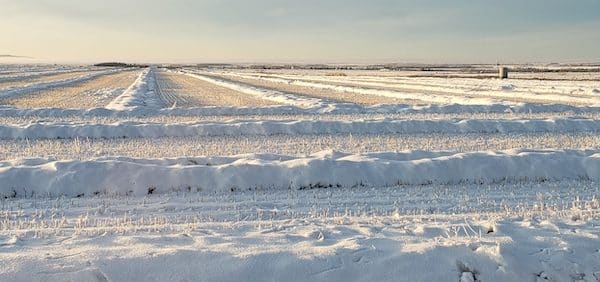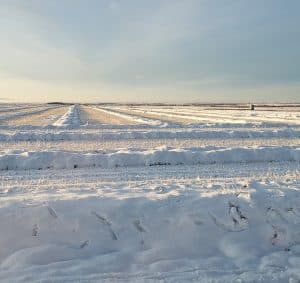Unharvested 2019 crop will be the first thing many Western Canadian farmers have to deal with this spring. There is no easy or one-size-fits-all answer for how to best handle these crops. The ideal option is probably to combine them because they’ll be worth something, crop insurance may require it, and this step removes most of the volunteer seedbank (some seeds will have shelled out) while also providing some residue management.
Another option for canola would be to seed directly into written-off cereal stands. In some cases, farmers will also consider destroying overwintered and written-off crop through cultivation or fire. Contact the insurance provider before taking any steps and contact the local municipal office before burning.
Andre Harpe, who is a director with Alberta Canola and farms at Valhalla Centre in the Peace River region, didn’t harvest any canola in the fall of 2019. It’s all still out in the field, half standing and half in swaths. He’s not alone.
“Farmers in this situation, we really need a focused plan,” Harpe says.
Ideally, field work in the Peace region usually starts around May 1 and seeding should really be done by May 30 at the latest, Harpe says. “Within that window, I’ve got about two weeks of harvest that has to get done this year. So we’re heading into two seasons – harvest and seeding – that are compressed into about a month.”
Harpe’s preferred option is to combine his overwintered crop. All told, he has 75 per cent of his harvest to complete as he did manage to harvest about half of his barley crop last fall. The rest of the barley has already been written off by crop insurance, but crop insurance hasn’t made an assessment on his canola. It wants him to harvest the crop. So he’ll try to combine it, then try to sell it.
Harpe had quite a bit of overwintered canola after the 2016 harvest, and the quality of his spring-harvested crop in 2017 was a No.3, on average, down from a No.1 for his fall-harvest canola. “It looked alright, but it had evidence of mould,” he says. “It also lost one quarter to one third of its yield due to shelling and shrinkage.” The elevator took it, but at a discount.
Local elevators have already expressed some interest in buying his overwintered canola from this year, but he’s uncertain about the grade and price with so much canola unharvested in the area. Another difference this year compared to spring 2017 is that the crop is covered in more snow and had higher moisture to begin with. “I’m not worried about the moisture because the crop is mature and has very little green,” he says, “but we really don’t know what’s out there in terms of quality and yield.”
An option would be to clean the harvested canola to make it “saleable,” but Harpe says local seed cleaning plants will probably be overwhelmed. So in the end, he will put a priority on harvesting the crop, then shop it around and hope for the best.
Quality considerations
Canadian Oilseed Processors Association (COPA), which represents the canola processors in Western Canada, knows that spring-harvested canola can be lower in weight, lower in oil content, higher in free fatty acid levels and at increased risk of animal damage.
“These factors pose a significant marketing risk to processors as customers demand consistent, high quality and safe oil and meal products,” says Chris Vervaet, executive director of COPA. “So, due to uncertainty surrounding the quality of canola harvested in the spring, oilseed processors will assess the physical and intrinsic quality attributes and make a decision as to whether to accept it, at that time.”
A tool that could help farmers with marketing is the Canadian Grain Commission (CGC) Harvest Sample Program. For the big picture, the Harvest Sample Program helps Canadian agriculture gain a better understanding of the quality situation for overwintered crop. And for the farmers who participate, they get an unofficial grade that can provide useful background information when it comes to negotiating a price.
The CGC ran a similar spring program in 2017. Of the 161 canola samples submitted that spring, 34 per cent were No.1, 26 per cent were No.2, 20 per cent No.3 and 20 per cent sample.
Farmers looking for buyers can check this list.
Practical tips are tough
Angela Brackenreed, agronomy specialist for the Canola Council of Canada, says, “Providing any practical tips on harvesting overwintered canola is tough because every situation will be unique and right now we just don’t know what the spring will look like.” Farmers in this situation “will have to endure a lot of trial and error,” she adds.
The other complicating factor is that harvest was delayed due to excess moisture, which means wet fields. When this water thaws, it could mean for a lot of mud – but not necessarily. Brackenreed says some farm meteorology specialists report that water is still moving down through the soil profile, and topsoil might dry out faster than expected – as long as we don’t get much more snow or spring rain.
Part of the planning, Brackenreed said, is to review what crops are going on what fields and assess the days to maturity and final crop insurance seeding dates for those crops. That will at least give farmers a timeline for when things need to get done.
And while all that is going on, Brackenreed reminds farmers to keep checking those bins of canola harvested last fall – especially as temperatures warm up and moisture starts moving again within the bin. This is yet another job, but she would hate for farmers to lose any of their higher quality grain that’s already harvested.
Include yourself in the plan
Part of Harpe’s “focused plan” will be to work closely with crop insurance on final assessment of his overwintered crops, make sure to follow the local county determination on burning (if it comes to that) and keep his financial institution in the loop.
He will also take care of himself.
Twenty years ago, Harpe expanded the farm and it was a really stressful time for him. “I went to my banker for advice and he said, ‘you have to get away and give yourself a bit of a break’,” Harpe says. “So we did, and it was good advice.” Harpe is thinking about that now as he waits and waits for what he hopes will be an early spring. “The break doesn’t have to be anything expensive, but it might just help to do something else besides looking at all those unharvested crops every day.”
Harvesting in the spring is never what a farmer in Western Canada wants to be doing. “But we went through this three years ago,” Harpe says, “and at the end of the day it’s not the end of the world.”

